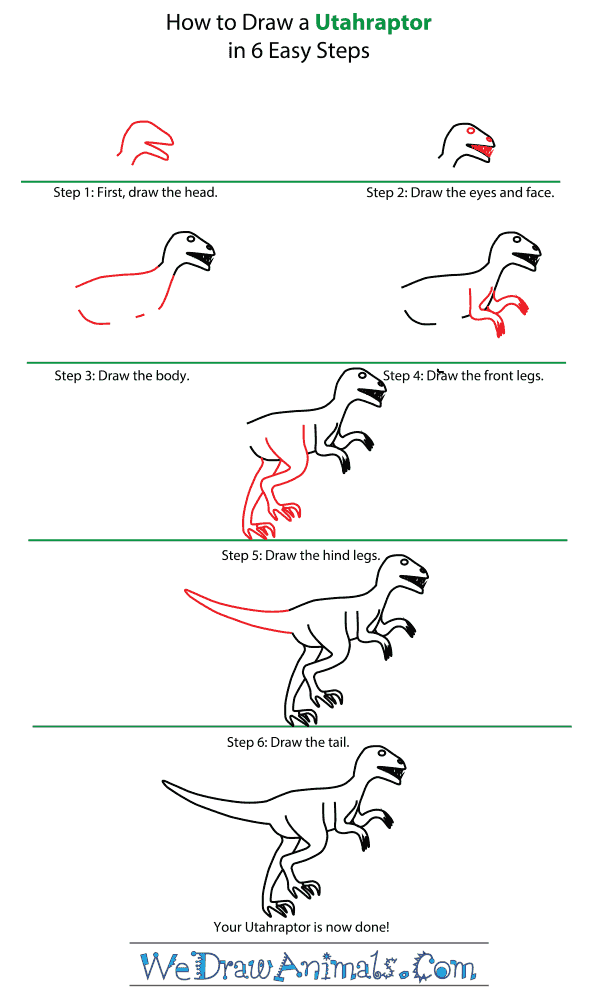In this quick tutorial you'll learn how to draw an Utahraptor in 6 easy steps - great for kids and novice artists.
The images above represent how your finished drawing is going to look and the steps involved.
Below are the individual steps - you can click on each one for a High Resolution printable PDF version.
At the bottom you can read some interesting facts about the Utahraptor.
Make sure you also check out any of the hundreds of drawing tutorials grouped by category.
How to Draw an Utahraptor - Step-by-Step Tutorial
Step 1: First, draw the head with an egg shape and a V-shaped opening to show the mouth, and the top of its narrow neck.
Step 2: Draw the eyes and face, with a large circle for the eye, a smaller circle for the nostril and large, sharp teeth in the mouth.
Step 3: Draw the body, starting with lines comes down from the head to show the slope of the neck to the underside, while the top of the neck, shoulders and back would be much flatter. Leave gaps for the front and hind legs.
Step 4: Draw the front legs, which were short but larger than those of dinosaurs like T-Rex. Utahraptor had very large, sharp claws at the end of muscular, narrow arms. Draw them bent at an L-shaped angle, ready to catch prey.
Step 5: Draw the hind legs, which are very long, with large thighs and narrow lower legs. The feet are large and flat with three sharp toes, and one claw on each foot curved upwards; this is Utahraptor’s most distinguishing feature. Draw one leg bent and raised to show it in motion.
Step 6: Draw the tail, which was longer than the body and would have stuck out straight and level for balance.
Interesting Facts about the UTAHRAPTOR
The Utahraptor is a member of the dinosaur group and the scientific term for them is U. ostrommaysorum. Their name “utah-raptor” means “Utah-predator” in English, which refers to how the fossil animal hunted within this particular territory name of the United States. They were long and slender two-legged predators, with a long and sharp claw on their feet that they used for tearing flesh. It is the largest known member of the Velociraptor’s family.
Did you know?
- The animal was first documented in 1993.
- This species was up to 23 feet long.
- They had a claw up to 3/4 of a foot in length.
- This creature weighed up to over 1,000 pounds.
- Their name “ostrom-mays-orum” was derived in 1993 for Mr. Ostrom and Mr. Mays for their efforts in promoting education for dinosaurs. Originally, the species Utahraptor spielbergi was considered to Steven Spielberg for his dinosaur movies and proposed funding of paleontology.
ontrary to popular belief, this animal possessed feathers. Evidence for this claim comes from the fossilized quill knobs found in modern birds, and that of this species’ relatives. Currently existing birds that don’t fly such as the Ostrich, Penguins, and Kiwis, don’t have quill knobs.







